
Zingiberidae is a botanical name at the rank of subclass. Circumscription of the subclass will vary with the taxonomic system being used (there are many such systems); the only requirement being that it includes the family Zingiberaceae.

Zingiberidae is a botanical name at the rank of subclass. Circumscription of the subclass will vary with the taxonomic system being used (there are many such systems); the only requirement being that it includes the family Zingiberaceae.
The Cronquist system (1981) treats this as one of four subclasses in class Liliopsida (=monocotyledons). It consists of:
The APG II system does not use formal botanical names above the rank of order. The plants involved here are assigned to order Zingiberales and Poales, both monocots.
| Wikimedia Commons has media related to Zingiberidae . |
| Wikispecies has information related to Zingiberidae . |

Bromeliales is an order of flowering plants. Such an order has been recognized by a few systems of plant taxonomy, with a various placement. It appears that it always has had the same circumscription: consisting only of the family Bromeliaceae, the bromeliad or pineapple family. The order is not recognized in the APG II system, of 2003, which places the plants involved in the order Poales. Some examples are:

Commelinales is an order of flowering plants. It comprises five families: Commelinaceae, Haemodoraceae, Hanguanaceae, Philydraceae, and Pontederiaceae. All the families combined contain over 885 species in about 70 genera; the majority of species are in the Commelinaceae. Plants in the order share a number of synapomorphies that tie them together, such as a lack of mycorrhizal associations and tapetal raphides. Estimates differ as to when the Comminales evolved, but most suggest an origin and diversification sometime during the mid- to late Cretaceous. Depending on the methods used, studies suggest a range of origin between 123 and 73 million years, with diversification occurring within the group 110 to 66 million years ago. The order's closest relatives are in the Zingiberales, which includes ginger, bananas, cardamom, and others.
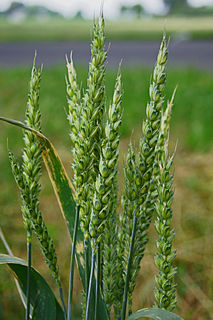
The Poales are a large order of flowering plants in the monocotyledons, and includes families of plants such as the grasses, bromeliads, and sedges. Sixteen plant families are currently recognized by botanists to be part of Poales.

The Zingiberales are flowering plants forming one of four orders in the commelinids clade of monocots, together with its sister order, Commelinales. The order includes 68 genera and 2,600 species. Zingiberales are a unique though morphologically diverse order that has been widely recognised as such over a long period of time. They are usually large herbaceous plants with rhizomatous root systems and lacking an aerial stem except when flowering. Flowers are usually large and showy, and the stamens are often modified (staminodes) to also form colourful petal-like structures that attract pollinators.
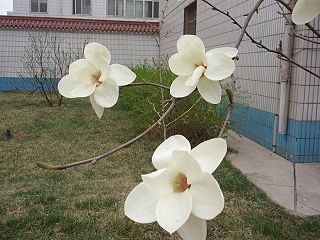
Magnoliopsida is a valid botanical name for a class of flowering plants. By definition the class will include the family Magnoliaceae, but its circumscription can otherwise vary, being more inclusive or less inclusive depending upon the classification system being discussed.

LiliopsidaBatsch is a botanical name for the class containing the family Liliaceae. It is considered synonymous with the name monocotyledon. Publication of the name is credited to Scopoli : see author citation (botany). This name is formed by replacing the termination -aceae in the name Liliaceae by the termination -opsida.
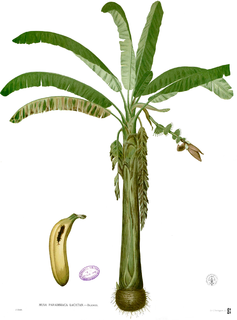
Musaceae is a family of flowering plants composed of three genera with ca 91 known species, placed in the order Zingiberales. The family is native to the tropics of Africa and Asia. The plants have a large herbaceous growth habit with leaves with overlapping basal sheaths that form a pseudostem making some members appear to be woody trees. In most treatments, the family has three genera, Musella, Musa and Ensete. Cultivated bananas are commercially important members of the family, and many others are grown as ornamental plants.
The Cronquist system is a taxonomic classification system of flowering plants. It was developed by Arthur Cronquist in a series of monographs and texts, including The Evolution and Classification of Flowering Plants and An Integrated System of Classification of Flowering Plants (1981).

Pandanales, the pandans or screw-pines, is an order of flowering plants placed in the monocot clade in the Angiosperm Phylogeny Group and Angiosperm Phylogeny Web systems. Within the monocots Pandanales are grouped in the lilioid monocots where they are in a sister group relationship with the Dioscoreales. Historically the order has consisted of a number of different families in different systems but modern classification of the order is based primarily on molecular phylogenetics despite diverse morphology which previously placed many of the families in other groupings based on apparent similarity. Members of the order have a subtropical distribution and includes trees, shrubs, and vines as well as herbaceous plants. The order consists of 5 families, 36 genera and about 1,610 species.
Alismatidae is a botanical name at the rank of subclass. Circumscription of the subclass will vary with the taxonomic system being used ; the only requirement being that it includes the family Alismataceae. It is a relatively new name: earlier systems, such as the Engler and Wettstein systems, used the name Helobiae for a comparable unit.
Hamamelididae is an obsolete botanical name at the rank of subclass. Because some hamamelidid members bear aments, this subclass has been formerly known as Amentiferae. Based on molecular phylogeny works, Hamamelididae appears to be a polyphyletic group.
Dillenidae is a botanical name at the rank of subclass. Circumscription of the subclass will vary with the taxonomic system being used; the only requirement being that it includes the family Dilleniaceae. A well-known system that uses this name is the Cronquist system, and in the original 1981 version of the system the circumscription was:
A system of plant taxonomy, the Takhtajan system of plant classification was published by Armen Takhtajan, in several versions from the 1950s onwards. It is usually compared to the Cronquist system. It admits paraphyletic groups.

In plant taxonomy, commelinids is a clade of flowering plants within the monocots, distinguished by having cell walls containing ferulic acid.
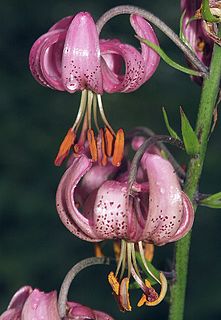
Liliidae is a botanical name at the rank of subclass. Circumscription of the subclass will vary with the taxonomic system being used ; the only requirement being that it includes the family Liliaceae.
Arecidae is a botanical name at the rank of subclass. Circumscription of the subclass will vary with the taxonomic system being used ; the only requirement being that it includes the family Arecaceae.
A 20th-century system of plant taxonomy, the Reveal system of plant classification was drawn up by the American botanist James Reveal (1941-2015). The system was published online in 1997 in ten parts as lecture notes comparing the major systems in use at that time. Subsequently, Reveal became an author with the consensus Angiosperm Phylogeny Group (APG) on the APG II 2003 and APG III 2009 processes. Although this largely supplanted the earlier and competing systems, he collaborated with Robert Thorne on his system (2007), and subsequently continued to develop his own system.
Scitamineae is a descriptive botanical name. Historically it has been applied to a remarkably stable group of flowering plants, now referred to as Zingiberales:

In biological classification, taxonomic rank is the relative level of a group of organisms in a taxonomic hierarchy. Examples of taxonomic ranks are species, genus, family, order, class, phylum, kingdom, domain, etc.
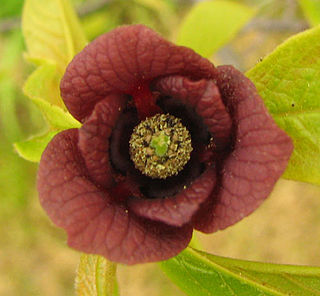
Magnoliids are a group of flowering plants. Until recently, the group included about 9,000 species, including magnolias, nutmeg, bay laurel, cinnamon, avocado, black pepper, tulip tree and many others. That group is characterized by trimerous flowers, pollen with one pore, and usually branching-veined leaves.